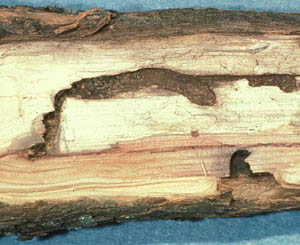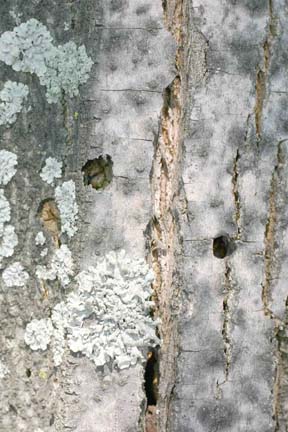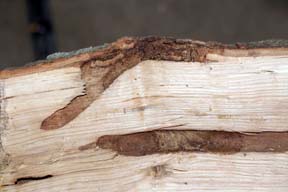Moth Borers of Ash | |
|---|---|
| June 14, 2007 | |
Ash/lilac borer and carpenterworm are moths whose caterpillars are borers in ash. They are commonly found when scouting for emerald ash borer. Particularly in recently transplanted trees, it is important to recognize the ash/lilac borer because it can cause severe damage and death of trees. Carpenterworm is more likely to be found in older, established ashes. Ash borer, also known as lilac borer, primarily attacks recently transplanted, stressed trees, and branches in larger trees with wounds from rubbing together, storm damage, or other causes. The damage to branches in large trees is not usually important to the health of the tree and may even aid in self-pruning activities of the tree. Ash borerís attack of young trees that have not yet adapted to site is a major problem in getting ash trees to establish.  The white, legless, cylindrical larvae grow to be about 1-1/2 inches long. They tunnel deeply through the trunk and branches, making round tunnels up to 1/4 inch in diameter. The larva keeps the tunnel free of frass by periodically pushing it out of its entrance hole in the bark.  When fully grown, the larva pupates in the tunnel near the bark surface, commonly with the pupa extending out of the bark, covered by a layer of silk and frass. The moth that emerges from this pupa frequently leaves the empty pupal case extending 1/4 to 1/2 inch out of the trunk or branch. These empty pupal cases may take several weeks to drop from the tree. When fully grown, the larva pupates in the tunnel near the bark surface, commonly with the pupa extending out of the bark, covered by a layer of silk and frass. The moth that emerges from this pupa frequently leaves the empty pupal case extending 1/4 to 1/2 inch out of the trunk or branch. These empty pupal cases may take several weeks to drop from the tree.The adult moth has clear, narrow wings, a slender body, and obvious antennae, making it appear wasplike. To add to this appearance, the moth flies during the day as wasps do and pulsates its abdomen as a wasp does when disturbed. Both the males and female moths are about 1 inch long. Because ash borers are serous pests of young trees, treatment with insecticides is common. Once the larva gets inside the tree, it is difficult to treat. For that reason, timing is critical to have an active insecticide residue on the bark when the eggs hatch. Eggs are laid in wounds, including borer emergence holes, because the moth has no chewing mouthparts or other mechanism for inserting the eggs below the bark surface. Pheromone traps are available that attract and capture males. Recording the number of males caught two or three times per week allows one to determine when there is peak abundance. Treatment of trunks and major branches of susceptible trees with permethrin (Astro, Pounce) is recommended 1 week after peak male catch. Treatment is also effective when Vanhoutte spirea is in full to late bloom, but the pheromone traps are better indicators of treatment time. Carpenterworm tunnels deep into the trunk and major branches of ash, oak, maple, poplar, and many other trees. Many tunnel through the wood to the pith, tunneling a foot or more up the center of the trunk or branch. Others create tunnels through the sapwood.  These insects have a 2-year life cycle, developing into very large caterpillars approaching 3 inches in length and 1/4 inch or more in diameter. As with other caterpillar borers, their tunnels are round in cross-section. They keep their tunnels free of frass by making periodical trips to the bark surface to expel the frass from the entrance hole. This results in holes 3/8 to 1/2 inch in diameter with frass clinging to the bark surface below it. The mature caterpillar pupates just inside the entrance hole, emerging as a large moth with a several-inch wingspan. The front wings have a gray and black pattern that blends in with the bark surface where the moth sits during the day. After the moth emerges, the empty pupal case is commonly found hanging out of the tunnel entrance, similar to that of the ash/lilac borer. Of course, this pupal case is much larger, 2 to 3 inches long and 3/8 to 1/2 inch in diameter. In the Great Plains states, carpenterworm frequently attacks trees in large numbers, causing severe dieback and entire tree death. However, in Illinois it is more typical for a tree to have only one or two entrance holes, indicating a very low infestation that does not generally warrant treatment. We have had a couple of recent reports of large numbers of carpenterworms being found in some individual ash trees. Most infestations in Illinois are found in trees with a trunk diameter of a foot or more. With entrance/exit holes are so large and obvious, treatment has been effective when directed at individual caterpillars. Excellent results have been obtained by running a wire up the tunnel to pierce the caterpillar. This method is particularly effective because insects have very poor abilities of regeneration and wound healing. More recently, injection of insecticidal nematodes into the holes has been effective. Use a syringe to squirt them deeply into the hole. Emergence of carpenterworm adults has just been reported in Illinois, so spraying the trunk and major branches with permethrin (Astro, Pounce) at this time should also be effective. Realize that with a 2-year life cycle, results from application now will not be determined for a year or more. |